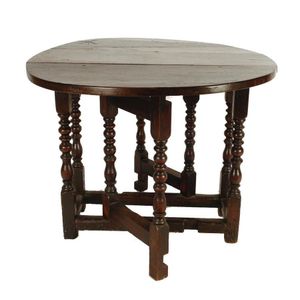Burr Walnut Drop Side Table with Bobbin Turned Legs
You must be a subscriber, and be logged in to view price and dealer details.
Subscribe Now to view actual auction price for this item
When you subscribe, you have the option of setting the currency in which to display prices to $Au, $US, $NZ or Stg.
- Burr - Burr (or in the USA, burl) is the timber from the knotted roots or deformed branch of the tree, which when cut, displays the small circular knots in various gradations of colour. It is always cut into a decorative veneer, most commonly seen as burr walnut on 19th century furniture.
- Turned Legs - are legs which have been turned on a lathe. In use from the 16th century, turned legs on tables, chairs and cabinets became more frequent until, by the 1830s, the Georgian square or tapered leg was rarely found except in country pieces.
- Victorian Period - The Victorian period of furniture and decorative arts design covers the reign of Queen Victoria from 1837 to 1901. There was not one dominant style of furniture in the Victorian period. Designers used and modified many historical styles such as Gothic, Tudor, Elizabethan, English Rococo, Neoclassical and others, although use of some styles, such as English Rococo and Gothic tended to dominate the furniture manufacture of the period.
The Victorian period was preceded by the Regency and William IV periods, and followed by the Edwardian period, named for Edward VII (1841 ? 1910) who was King of the United Kingdom and the British Dominions and Emperor of India for the brief period from 1901 until his death in 1910. - Bobbin Turning - This turning resembles a series of compressed spheres, not unlike a row of beads or bobbins. Commonly associated with Jacobean-style furniture, bobbin turning is also found on a wide variety of small cedar and pine tables and washstands made in Australia during the late 19th century and up to the first world war.
- Turning - Any part of a piece of furniture that has been turned and shaped with chisels on a lathe. Turned sections include legs, columns, feet, finials, pedestals, stretchers, spindles etc. There have been many varieties and fashions over the centuries: baluster, melon, barley-sugar, bobbin, cotton-reel, rope-twist, and so on. Split turning implies a turned section that has been cut in half lengthwise and applied to a cabinet front as a false decorative support.
This item has been included into following indexes:
Visually similar items

An early 20th century circular hall table in oak, on six turned legs, in excellent condition, height 71.5 cm, diameter 51 cm

An adjustable timber top stool

A small proportion 18th century gateleg table, the oval top raised on baluster and bobbin turned legs joined with stretchers. 90.5 cm x 77 cm x 60 cm

A Jacobean style oak drop side table, early 20th century. in warm tonings, the oval table having barley twist legs and fold out stretcher based supports with square form bases and ball feet. Height 73 cm. Width 106 cm. Depth 79 cm
